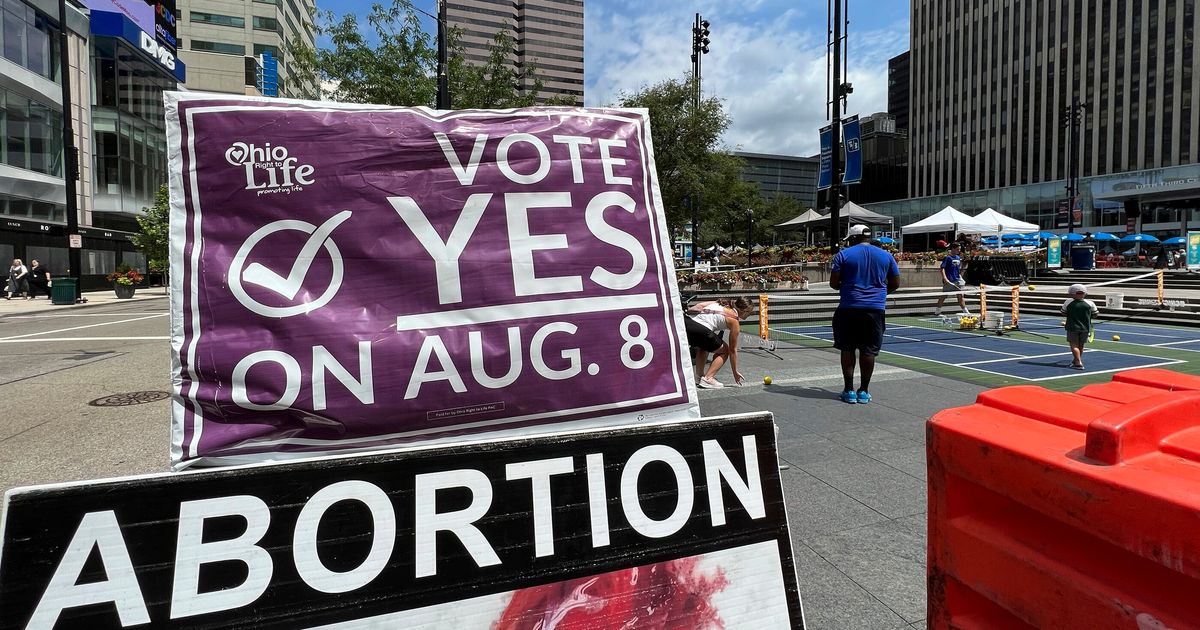
The results of an Ohio referendum could have far-reaching consequences for abortion rights in the state ― and activists and donors on both sides of the issue are acting accordingly.
Ohioans head to the polls on Tuesday to cast their ballots in a special election over whether to raise the vote threshold needed to pass an amendment to the state’s constitution.
A “yes” vote on the Republican-backed ballot initiative, Issue 1, would change the rules to require a 60% majority for voters to pass an amendment to change the state’s constitution ― an increase from the current threshold, a simple majority of over 50%.
Issue 1 would also increase the petition requirements for getting such an amendment on the ballot in the first place.
The Issue 1 requirements are ultimately a proxy fight over abortion rights. Ohio Republicans pushed for the special election to pass Issue 1 in anticipation of a liberal-backed referendum, due to appear on the ballot in November, that would enshrine abortion rights in the state constitution.
If successful, that November amendment would effectively invalidate any laws that bar abortion before the point of fetal viability, including a state law currently on the books that would prohibit abortion after six weeks of pregnancy. (In October, a county judge placed a hold on that law, arguing that it violates a right to abortion that is already implicit in the state constitution; abortion rights advocates seek to make the right explicit and thus more resistant to challenges.)
Ohio Republicans are betting that if a 60% majority is required to enshrine abortion rights in the state’s constitution, abortion rights advocates are less likely to succeed. And indeed, a late July poll found that 58% of Ohioans supported passing the amendment to protect abortion rights — a clear majority, but one that falls below 60%.
As for Issue 1 itself, the latest public poll shows a neck-and-neck race, with a slight edge for the “yes” side and a sizable share of voters who remain undecided.
Given the stakes and the close attention from national groups with strong views on abortion rights, spending in the off-season special election has ballooned to $35 million as of the end of July.
With help from GOP billionaire Dick Uihlein of Illinois and the anti-abortion group Susan B. Anthony List, proponents of a “yes” vote on Issue 1 have raised about $20 million to advance their cause. Meanwhile, the “no” side has raised some $14.8 million. Major donors to the umbrella group seeking to defeat Issue 1 include liberal mega-donor Karla Jurvetson and the Tides Foundation, both based in California.
There are also implications in the referendum for other policy priorities, such as an increase in the minimum wage. A constitutional amendment on the ballot this November would increase Ohio’s minimum wage to $15 an hour by 2026, and index it to inflation thereafter. The state Chamber of Commerce, which opposes the minimum wage hike, has thus come out in favor of Issue 1’s passage.
August special elections are typically low-turnout affairs, but the number of ballots cast during the month of early voting has exceeded expectations on both sides. As of last Wednesday, more than 500,000 people had voted by mail or in person, according to The Associated Press — surpassing the early voting figures for the two most recent midterm elections. Voters in some counties endured lines that stretched around buildings amid a brutal summer heat wave.
The ballot measure is a flashpoint in Ohio’s already contentious 2024 Republican Senate primary. GOP state Secretary of State Frank LaRose, who launched a bid for U.S. Senate last month, is overseeing the administration of the election as the state’s chief elections officer, while also advocating for the substance of the measure as a means to stop the legalization of abortion. LaRose has called on his two wealthy opponents in the race, state Sen. Matt Dolan and businessman Bernie Moreno, to each personally contribute $1 million to supporting Issue 1, which the rival campaigns have dismissed as a stunt.
Abortion is expected to be a major focus of the contest between Sen. Sherrod Brown (D-Ohio), one of the Republican Party’s top targets in its quest to control the Senate, and whoever is the state’s eventual GOP nominee. Regardless of what happens this week, if abortion rights advocates triumph later this year, Brown can use that to his advantage to argue that his opponent is out of step with Ohio voters — and the reverse can be said of Brown if they’re unsuccessful.

